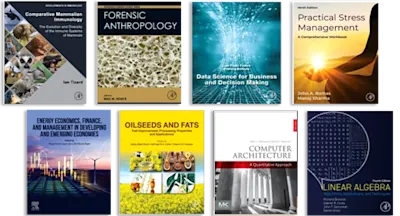
Geological History of Earth's Climate
- 1st Edition - February 1, 2026
- Imprint: Elsevier
- Authors: F.P. Agterberg, Eric Grunsky
- Language: English
- Paperback ISBN:9 7 8 - 0 - 4 4 3 - 2 6 5 9 0 - 7
- eBook ISBN:9 7 8 - 0 - 4 4 3 - 2 6 5 9 1 - 4
Geologic History of the Earth’s Climate offers an exhaustive examination of Earth's climate oscillations across the Paleozoic, Mesozoic, and Cenozoic eras. Through advanced mat… Read more
Purchase options

- Links climate change to the linear Phanerozoic time scale, using current stage boundary age estimates
- Includes detailed spectral analysis and multifractal theory, discussing the spectra for autocorrelated observations along time or space series
- Presents an approach that considers the possibility of today's short-term climate change surpassing the expectations of most current models
2. Greenhouse Effect
3. Anthropocene Earth Temperature Increase
4. CO2 Capture and Permanent Deactivation Methods
5. Phanerozoic Paleoclimates
6 Effect of uncertainties in stage boundary age estimates on paleoclimate history
7. Earth’s History of Atmospheric CO2 and CH4 Concentration Values
8. Spectral Analysis and Multifractal Theory
9. Lovejoy-Schertzer’s Weather, Macroweather and Climate Modeling
10. Pareto-Lognormal Frequency Distributions
11. Recent Heavy-Tail Climatic Frequency Distribution Applications
12. Concluding Remarks and Future Developments
- Edition: 1
- Published: February 1, 2026
- Imprint: Elsevier
- Language: English
FA
F.P. Agterberg
F.P. Agterberg obtained his PhD at Utrecht University in 1961. After a 1-year post-doctorate Fellowship of the Wisconsin Alumni Research Foundation in Madison, he joined the Geological Survey of Canada in Ottawa where he headed the Geomathematics Section from 1969 to 1996.He has published over 350 scientific papers and 4 books including “Geomathematics” in 1974 which sold about 10,000 copies. During the past 7 years he has helped to estimate the ages of 6 GTS200 stage boundaries, and was a co-editor of the Encyclopedia of Mathematical Geosciences in which he also authored 24 chapters. From1968 he was associated with the University of Ottawa where he taught “statistics in geology” for 25 years. In total, he has supervised about 20 students in Canada and China. Other positions included directing the Quantitative Stratigraphy Project of the International Geological Correlation Program. He became Correspondent of the Royal Dutch Academy of Sciences in 1981 and was President of the International Association for Mathematical Geosciences (2004-2008),
EG